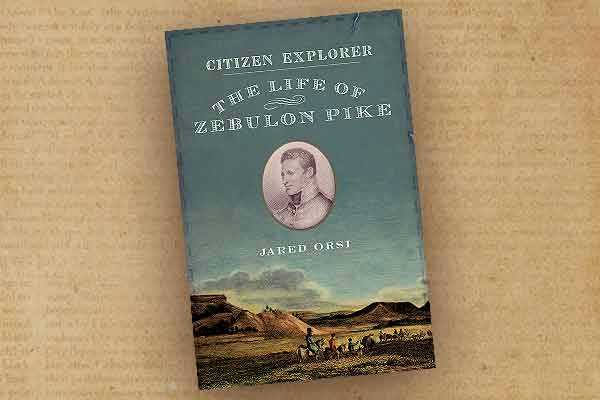 Born in Somerset, New Jersey, on January 5, 1779, into a patriotic family battling the British for American independence, Zebulon Montgomery Pike was weaned on heroism and love of country, a child of the Revolution and westward expansion, destined for greatness and American immortality.
Born in Somerset, New Jersey, on January 5, 1779, into a patriotic family battling the British for American independence, Zebulon Montgomery Pike was weaned on heroism and love of country, a child of the Revolution and westward expansion, destined for greatness and American immortality.
Colorado State University History Professor Jared Orsi’s Citizen Explorer: The Life of Zebulon Pike is the first major re-examination of the adventurer-soldier’s life since John Upton Terrell’s biography published in 1968. Orsi’s study of Pike is extremely well-researched and is finely documented with annotated endnotes and a detailed bibliography. In addition to his primary research on Pike, Orsi provides the reader with a strong contextualization of the parallel historical events, competing empires, Indian nations, and national leaders who influenced domestic, national and foreign policy during Pike’s short life. Orsi’s broader interpretation restores our understanding of Pike as one of America’s first Western heroes.
Pike had been soldiering since he was 15 years old when he was mortally wounded in the War of 1812’s Battle of York on April 27, 1813. At the time of his death at 34 years old, Pike was considered a national hero, a martyr of a young nation whose adventurous life exemplified the sacrifice needed to secure the promise of an independent United States—and an independent citizenry. According to Orsi’s book, “…at the end of his life, Pike was more highly regarded than Meriwether Lewis…. More than military prowess and psychological stability, however, distinguished Pike’s brief celebrity from Lewis’s early ignominy. Pike’s story provided the raw material for hagiography because his life reflected America’s central promise.”
Before he was a heroic American general, Pike was a young army lieutenant who President Thomas Jefferson commissioned to be the first explorer after Lewis and Clark to survey the vast Louisiana Territory. Familiar with the Ohio River Valley since his youth growing up in western Pennsylvania and Ohio, he was adventurous and fearless, eager to explore and had already completed a major survey of the Upper Mississippi River to its source. His transit west across the Plains into the Rocky Mountains, and south into New Spain remains one of the greatest feats of exploration, and best documented, in the early 19th century. More important, his published account
in 1810 of his expedition became the primary guide for successive explorations, and had a more profound effect on America’s westward expansion in the first decades of the new century than anyone else’s surveys.
Orsi is not content to leave Pike’s story in the 19th century, but expertly places Pike’s life, and the legacy of Pike’s Peak, in context to travel, tourism and development of the modern West, including the lesser known story of how the majestic mountain inspired the lyrics for “America the Beautiful.” Orsi’s conclusions on Pike, as explorer, adventurer, philosopher, and patriot, should lead us to a new understanding of America’s continental explorers and their ongoing influence on what we believe the American West is, and for that matter, what it can be.
— Stuart Rosebrook






